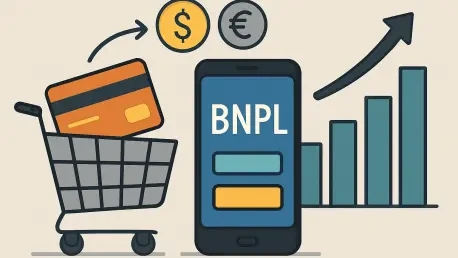The e-commerce Buy Now Pay Later (BNPL) market is experiencing a transformative surge, fundamentally altering how consumers and retailers engage in online transactions across the globe. As highlighted in a comprehensive report released on October 6, 2025, by a leading market research firm, this innovative payment solution—allowing shoppers to split online purchases into interest-free installments—is rapidly becoming a pivotal element of digital commerce. Projections indicate that the BNPL sector will grow from a substantial $9.56 billion in 2025 to an impressive $30.74 billion by 2029, reflecting a robust compound annual growth rate (CAGR) of 33.9%. This remarkable trajectory is fueled by the escalating popularity of online shopping, which recorded global sales of $1.19 trillion in 2024. The seamless blend of BNPL’s affordability with the convenience of e-commerce platforms is creating a dynamic environment, offering significant opportunities for both merchants aiming to boost sales and consumers seeking flexible payment options in an increasingly digital marketplace.
Surging Market Expansion and Future Outlook
The BNPL market within e-commerce is on a steep upward climb, with financial figures painting a vivid picture of its potential. Starting from a valuation of $7.16 billion in 2024, the market is anticipated to reach $9.56 billion in 2025 and is forecasted to balloon to $30.74 billion by 2029. This growth, driven by a CAGR of 33.9% over the next four years, underscores the increasing consumer preference for flexible payment models over traditional credit systems. A key factor propelling this expansion is the dramatic rise in online shopping, which continues to reshape retail landscapes worldwide. As digital transactions become the norm, BNPL services are enhancing purchasing power for a wide range of consumers, enabling them to manage expenses more effectively while providing retailers with tools to increase conversion rates at checkout. This synergy between e-commerce growth and BNPL adoption signals a transformative shift in how financial transactions are conducted in the digital realm.
Beyond the raw numbers, the implications of this market surge are profound for the broader retail ecosystem. The rapid adoption of BNPL reflects a deeper cultural shift toward immediacy and affordability in consumer behavior, particularly in online spaces where competition for attention is fierce. Retailers are leveraging these payment solutions not just as a transactional tool but as a strategic asset to build customer loyalty and drive repeat business. Meanwhile, the consistent growth trajectory suggests that BNPL providers must scale their operations and infrastructure to meet rising demand, ensuring seamless integration with diverse e-commerce platforms. Additionally, this expansion is drawing attention from investors and financial institutions, eager to capitalize on a sector that shows no signs of slowing down. As the market evolves toward 2029, stakeholders across the spectrum will need to adapt to changing dynamics, balancing growth opportunities with the need for robust risk management strategies to sustain long-term success.
Technology as a Catalyst for BNPL Evolution
Technological advancements are playing a central role in the meteoric rise of BNPL services within the e-commerce sector, enhancing both functionality and security for users and merchants alike. Innovations such as biometric authentication are bolstering trust by ensuring secure transactions, while AI and machine learning algorithms are being utilized to create personalized payment plans tailored to individual consumer needs. Furthermore, sophisticated fraud detection systems are mitigating risks, making BNPL a safer option in an era of increasing cyber threats. A notable example of tech-driven progress is the partnership between Splitit and SAP Commerce Cloud, initiated in March 2023, which simplifies the integration of installment payment options for merchants without requiring extensive backend development. These technological strides are not only making BNPL more accessible but are also setting new industry standards for convenience and reliability in digital payments.
The impact of these technological innovations extends far beyond operational improvements, influencing how BNPL providers compete and collaborate in a crowded market. Seamless integrations with e-commerce platforms and mobile payment solutions are becoming essential, allowing merchants to offer BNPL options directly at the point of sale with minimal friction. This ease of adoption is critical for smaller retailers who may lack the resources to build complex payment infrastructures independently. Additionally, the use of AI to analyze consumer behavior is enabling providers to predict payment defaults and adjust terms proactively, reducing financial risks. As technology continues to evolve, it is likely that BNPL services will incorporate even more cutting-edge tools, such as blockchain for transaction transparency or augmented reality for enhanced shopping experiences, further embedding these payment solutions into the fabric of online retail. This tech-driven transformation is a key pillar supporting the market’s projected growth through 2029.
Adoption Trends Among Consumers and Merchants
The widespread embrace of BNPL by both consumers and merchants is a driving force behind the market’s rapid expansion, reshaping purchasing habits and retail strategies in tandem. Among consumers, particularly younger demographics like Generation Z and Millennials, the appeal lies in the affordability and flexibility of interest-free installments, which allow for better budget management without the burden of traditional credit debt. However, the report reveals that this payment model’s allure is not limited to younger shoppers; it spans across age groups, including Generation X and even Baby Boomers, demonstrating its universal applicability. This broad demographic reach is encouraging more individuals to engage in online shopping with confidence, knowing they can spread costs over time. For consumers, BNPL represents not just a payment option but a financial tool that aligns with modern economic realities, fostering greater participation in the digital economy.
Merchants, on the other hand, are increasingly integrating BNPL options into their checkout processes as a means to attract a wider customer base and accelerate sales growth. By offering installment payments, retailers are witnessing higher conversion rates and larger average order values, as shoppers feel empowered to purchase items they might otherwise defer. This strategy also enhances customer loyalty, as the convenience of BNPL encourages repeat business in a highly competitive online marketplace. Major players in the retail space are partnering with BNPL providers to streamline these offerings, recognizing that such payment flexibility can be a significant differentiator. However, merchants must also navigate the costs associated with implementing these services, balancing the immediate benefits of increased sales against potential long-term financial commitments. As adoption continues to rise across both consumer and merchant segments, BNPL is solidifying its position as a critical component of e-commerce strategy, driving mutual benefits for all parties involved.
Geographic Growth and Economic Headwinds
Regionally, the BNPL market is witnessing varied growth patterns, with the Asia-Pacific region emerging as a powerhouse due to its rapid e-commerce expansion and widespread smartphone usage. High internet penetration and a burgeoning middle class in countries across this area are creating fertile ground for digital payment solutions like BNPL, enabling consumers to access a broader range of goods and services online. This regional dynamism is a significant contributor to the global market’s upward trajectory, as providers tailor their offerings to meet diverse cultural and economic needs. The robust growth in Asia-Pacific serves as a blueprint for other regions, highlighting the importance of localized strategies in scaling BNPL adoption. As e-commerce continues to flourish in these markets, the integration of BNPL is expected to deepen, further amplifying transaction volumes and market value through the forecast period ending in 2029.
Despite the optimistic regional outlook, the BNPL market is not without its challenges, particularly when it comes to economic and regulatory factors that could temper growth. In the U.S., for instance, tariffs and escalating licensing fees for real-time credit decisioning systems—often developed in countries like Sweden and Australia—are creating additional costs for providers and merchants alike. These economic pressures are projected to result in a slight 0.2% reduction in the overall CAGR, illustrating how global trade tensions can ripple through the financial services sector. While these hurdles are not expected to derail the market’s progress, they underscore the importance of strategic planning to mitigate risks associated with international cost structures. Stakeholders must remain vigilant, adapting to policy changes and economic fluctuations to ensure that BNPL services remain competitive and accessible, even in the face of such external constraints impacting operational budgets.
Competitive Strategies and Emerging Trends
The competitive landscape of the BNPL market is heating up, with major players and strategic maneuvers shaping the industry’s future direction. Companies like Amazon, PayPal, Klarna, and Affirm are at the forefront, driving innovation and market share through robust service offerings and extensive partnerships with online retailers. A landmark event in this space was Block Inc.’s acquisition of Afterpay for $24.53 billion in February 2022, a move aimed at expanding financial service capabilities and enhancing merchant revenue streams. Such consolidations highlight the trend toward integrating BNPL with broader financial ecosystems, creating comprehensive solutions that benefit both providers and retail partners. This competitive intensity is fostering an environment of continuous improvement, as companies vie to offer the most seamless and attractive payment options to capture consumer and merchant interest.
Beyond corporate strategies, broader industry trends are also defining the BNPL space, particularly the growing synergy between these payment models and e-commerce platforms. The integration of BNPL services at checkout is becoming a standard expectation rather than a novelty, driven by consumer demand for flexibility and convenience. Additionally, the market is diversifying across product categories, with strong adoption in fashion, electronics, and home goods, as well as varying transaction sizes from small to large ticket items. Payment methods are evolving too, encompassing credit cards, debit cards, digital wallets, and bank transfers, ensuring accessibility for a wide audience. As these trends converge, the BNPL market is poised for sustained innovation, with providers likely to explore new repayment models and technological enhancements to stay ahead. Looking back, the strategic decisions and trend adaptations made in recent years laid a strong foundation for the remarkable growth that defines this dynamic sector.









